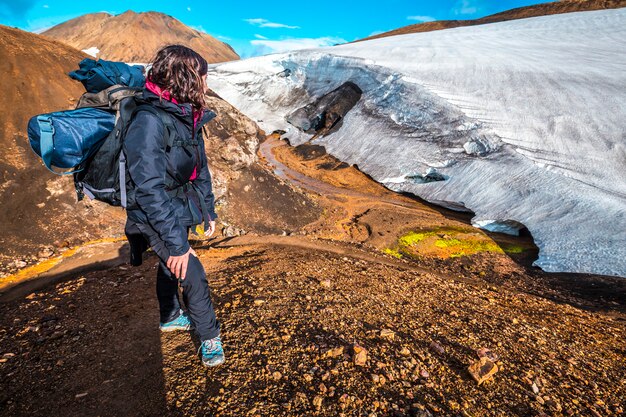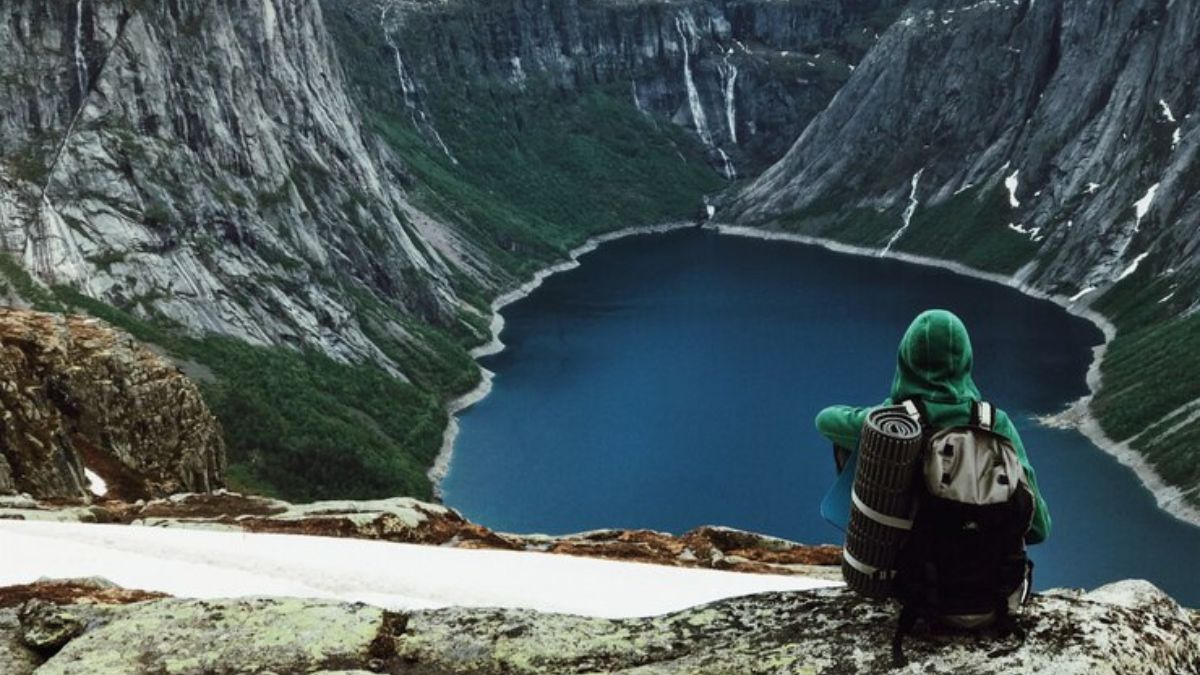The Manaslu Circuit Trek stands as a hidden gem in the heart of the Himalayas, offering adventurers a journey of unparalleled beauty and cultural immersion. Nestled in the remote corners of Nepal, this trek encircles the eighth highest peak in the world, Mount Manaslu (8,163 meters), and traverses through diverse landscapes, from lush green foothills to high-altitude passes adorned with pristine snow.
The allure of the Manaslu Circuit Trek lies in its untouched natural beauty and breathtaking vistas. The trail winds through dense forests of rhododendron, pine, and bamboo, where elusive wildlife like the Himalayan tahr and snow leopard roam freely. As trekkers ascend, the landscape transitions into alpine meadows dotted with glacial lakes and towering peaks. The highlight of the trek is crossing the Larkya La Pass (5,160 meters), where panoramic views of Manaslu and neighboring peaks reward those who brave the altitude and rugged terrain.
Beyond its natural splendor, the Manaslu Circuit Trek offers deep cultural immersion. The trail winds through traditional Tibetan villages adorned with colorful prayer flags and intricately carved mani walls, where the ancient Buddhist monasteries and chortens (stupas) stand as testaments to centuries-old traditions. Villagers warmly welcome trekkers into their homes and teahouses, offering insights into their daily lives, culinary traditions, and spiritual practices. This cultural exchange fosters a profound understanding of the region’s heritage and strengthens the bonds between trekkers and locals.
The Manaslu Circuit Trek is renowned for its challenges and rewards, making it a favorite among seasoned trekkers seeking remote and less-traveled routes. Trekkers must be prepared for long days of hiking over varied terrain, acclimatization to high altitudes, and unpredictable weather conditions. However, the rewards are ample: each day brings new landscapes to explore, from tranquil forests and terraced fields to rugged mountain passes with unparalleled views. The sense of accomplishment upon reaching the Larkya La Pass and descending into the Marsyangdi Valley is unparalleled, offering trekkers a profound connection to the natural world and their own inner strength.
As popularity grows, efforts to maintain the trek’s pristine environment and support local communities have become paramount. Conservation initiatives focus on responsible waste management, reforestation projects, and sustainable tourism practices that respect the delicate ecosystem and cultural heritage of the region. Local lodges and teahouses provide employment opportunities for villagers, ensuring that tourism revenue directly benefits the communities along the trekking route.
The Manaslu Circuit Trek is not merely a physical journey but a transformative experience that immerses trekkers in the soul-stirring beauty of the Himalayas and the rich cultural tapestry of Nepal. It challenges adventurers to push their limits, connect with nature in its purest form, and forge lasting memories amidst some of the world’s highest peaks. Whether seeking solitude, cultural enlightenment, or the thrill of exploration, the Manaslu Circuit Trek promises an unforgettable odyssey into the heart of the Himalayas, where every step unveils a new facet of this majestic landscape.
Introduction: Discovering the allure of the Manaslu Circuit Trek
The Manaslu Circuit Trek presents adventurers with a less-traveled path into the heart of the Nepalese Himalayas, offering a unique blend of natural beauty, cultural immersion, and remote wilderness. Nestled in the shadow of Mount Manaslu, the eighth highest peak in the world, this trek promises stunning landscapes ranging from verdant forests and terraced hillsides to rugged alpine terrain adorned with glaciers and towering peaks. Unlike its more popular counterparts, the Annapurna and Everest regions, the Manaslu Circuit Trek offers a quieter, more authentic experience where trekkers can connect deeply with both nature and local culture. The allure lies in its pristine environment, rich cultural heritage, and the opportunity to trek through unspoiled landscapes while encountering traditional villages and ancient monasteries along the way.
Trek Overview: Understanding the route and key highlights of the trek
The Trek to Manaslu Circuit typically spans around 14 to 18 days, covering approximately 177 kilometers (110 miles) in total distance. Starting from the village of Soti Khola, the trek follows the Budhi Gandaki River gorge before ascending through lush forests of rhododendron and bamboo. As trekkers gradually gain altitude, the landscape transitions to high-altitude pastures, glacial lakes, and majestic views of snow-capped peaks including Manaslu itself. The trek culminates in crossing the challenging Larkya La Pass (5,160 meters), which offers panoramic vistas of the entire Manaslu range and neighboring peaks. Descending from the pass, trekkers enter the Marsyangdi Valley, passing through traditional Tibetan-influenced villages before concluding in the town of Besisahar.
Permits and Regulations: Navigating the necessary permits and regulations for the trek
To trek the Manaslu Circuit, trekkers must obtain both a restricted area permit and an Annapurna Conservation Area Permit (ACAP). The restricted area permit is essential due to the trek’s proximity to the Tibetan border and is obtained through a registered trekking agency. Additionally, trekkers must be part of a minimum of two persons to obtain the permit. The ACAP permit is required as the trek passes through the Annapurna Conservation Area, a protected region that ensures the preservation of its biodiversity and cultural heritage. Trekkers must carry their permits at all times and register at checkpoints along the route to ensure compliance with regulations.
Best Time to Trek: Determining the ideal time to embark on the Manaslu Circuit Trek
The best time to embark on the Manaslu Circuit Trek is during the spring (March to May) and autumn (September to November) seasons. During these months, the weather is generally stable, with clear skies and moderate temperatures conducive to trekking. Spring brings vibrant rhododendron blooms and lush greenery, while autumn offers clear views of snow-capped peaks and comfortable daytime temperatures. Winter (December to February) brings cold temperatures and snowfall, particularly at higher altitudes, making trekking challenging and requiring specialized gear. The monsoon season (June to August) brings heavy rainfall and landslides, rendering many sections of the trail impassable and not recommended for trekking. Careful consideration of weather patterns and seasonal variations is essential when planning the timing of the Manaslu Circuit Trek to ensure a safe and enjoyable experience.
Trekking Itinerary: Outlining the day-by-day plan for the trek
The Manaslu Circuit Trek typically spans 14 to 18 days, depending on the chosen itinerary and trekking pace. A standard itinerary includes:
1 Arrival in Kathmandu: Obtain permits and prepare for the trek.
2 Drive to Soti Khola: Start trekking from the village, following the Budhi Gandaki River.
3 Trek to Machha Khola: Continue along the river, passing through Gurung villages and terraced fields.
4 Trek to Jagat: Ascend through subtropical forests and cross suspension bridges.
5 Trek to Deng: Trek through forests and Mani walls, gaining altitude.
6 Trek to Namrung: Enter the Nupri region, characterized by Tibetan-influenced culture.
7 Trek to Samagaon: Reach a picturesque village with views of Manaslu and explore nearby monasteries.
8 Acclimatization Day: Rest and explore Samagaon or hike to Pungyen Gompa for acclimatization.
9 Trek to Samdo: Ascend to the Tibetan border village, offering views of glaciers.
10 Trek to Dharamsala (Larkya Phedi): Prepare for crossing Larkya La Pass, acclimatizing at higher altitude.
11 Cross Larkya La Pass to Bimthang: Start early for the challenging pass and descend into the Marsyangdi Valley.
12 Trek to Tilije: Descend through forests and terraced fields, passing through traditional villages.
13 Trek to Tal: Continue through the Marsyangdi Valley, enjoying diverse landscapes.
14 Trek to Syange and Drive to Besisahar: Conclude trekking and drive back to Besisahar.
This day-by-day plan allows trekkers to acclimatize gradually, enjoy the stunning scenery, and experience the cultural diversity of the Manaslu region while completing the challenging trek.
These descriptions provide a comprehensive overview of the 14 Day Manaslu Circuit Trek, covering its allure, route details, necessary permits and regulations, ideal trekking seasons, and a typical day-by-day itinerary.
Physical Fitness and Training: Preparing your body for the challenges of the trek
The Manaslu Circuit Trek demands a good level of physical fitness due to its rugged terrain, high altitudes, and long trekking days. It’s essential to engage in a comprehensive training regimen before embarking on the trek. Focus on cardiovascular exercises such as hiking, running, or cycling to improve endurance. Strength training for leg muscles and core stability will help you navigate steep ascents and descents. Additionally, practice hiking with a loaded backpack to simulate the conditions you’ll encounter on the trail. Gradual acclimatization is crucial, so plan to include hikes at higher altitudes in your training schedule. Adequate rest and recovery are also essential to prevent injuries and ensure peak performance during the trek. By preparing your body through targeted fitness and conditioning, you’ll enhance your ability to enjoy the stunning landscapes and cultural experiences that await on the Manaslu Circuit Trek.
Accommodation Options: Exploring the different lodging choices along the trek
Accommodation on the Manaslu Circuit Trek ranges from basic teahouses to more comfortable lodges, offering a variety of choices to suit different preferences and budgets. Teahouses are the most common accommodation option, providing simple rooms with twin beds, blankets, and shared bathrooms. They also serve meals in communal dining halls, offering a chance to socialize with fellow trekkers. Some teahouses may have amenities like hot showers and charging stations, although these facilities can be limited at higher altitudes. Lodges are available in larger villages like Samagaon and Bimthang, offering more comfort with private rooms, attached bathrooms, and additional services such as WiFi and hot water. For those seeking a more immersive experience, homestays with local families provide an opportunity to experience traditional Nepalese hospitality firsthand. Trekkers are encouraged to book accommodation in advance during peak seasons to ensure availability and secure preferred lodging options along the Manaslu Circuit Trek.
Dining and Food: Sampling the local cuisine and dining options during the trek
Dining on the Manaslu Circuit Trek offers trekkers a taste of traditional Nepalese cuisine along with familiar western dishes, ensuring a satisfying culinary experience throughout the journey. Teahouses and lodges along the trail serve hearty meals designed to replenish energy levels and cater to varying dietary preferences. Typical meals include dal bhat (rice with lentil soup), noodles, fried rice, momos (dumplings), and local curries featuring fresh vegetables and meats. Breakfast options often include eggs, pancakes, porridge, and Tibetan bread served with honey or jam. Trekkers can enjoy hot beverages such as tea, coffee, and hot chocolate to warm up during chilly mornings or relax after a day of trekking. As you ascend in altitude, the availability of fresh produce and ingredients may decrease, so expect menus to become more limited. Despite these challenges, local chefs and kitchen staff work diligently to provide nourishing meals that showcase the flavors of the region while accommodating dietary needs. Dining during the Manaslu Circuit Trek is not just about sustenance but also a cultural experience that connects trekkers with the culinary traditions and hospitality of the Nepalese Himalayas.
Cultural Immersion: Experiencing the rich cultural heritage of the region
The Manaslu Circuit Trek offers trekkers a profound opportunity for cultural immersion, showcasing the diverse heritage and traditions of the region’s inhabitants. Throughout the journey, trekkers pass through traditional villages inhabited by Gurung, Tibetan, and other ethnic communities, each with its own distinct customs and lifestyle. Along the trail, encounter ancient Buddhist monasteries adorned with prayer flags and intricately carved mani stones, which serve as spiritual landmarks and cultural repositories. Participate in local festivals, ceremonies, and cultural performances that celebrate the region’s rich history and religious beliefs. Engage with villagers and learn about their daily lives, agricultural practices, and artisanal crafts such as weaving and pottery. Staying at teahouses and homestays provides opportunities to interact with local families, share meals, and gain insights into their traditions and values. By embracing cultural immersion on the Manaslu Circuit Trek, trekkers foster mutual respect, understanding, and appreciation for the enduring heritage that shapes life in the remote Himalayan communities.
Natural Beauty: Marveling at the breathtaking landscapes and mountain vistas
The Manaslu Circuit Trek unfolds through some of the most breathtaking landscapes in the Himalayas, offering trekkers unparalleled views of towering peaks, serene valleys, and diverse ecosystems. Begin the journey amidst lush green forests of rhododendron, oak, and pine, alive with the songs of native birds and the rustling of wildlife. Ascend through terraced fields and traditional villages where local farmers tend to crops against the backdrop of snow-capped mountains. Traverse high-altitude pastures dotted with grazing yaks and pristine glacial lakes reflecting the azure sky above. The highlight of the trek is crossing the formidable Larkya La Pass (5,160 meters), where trekkers are rewarded with panoramic vistas of Manaslu, Himlung Himal, Cheo Himal, and the Annapurna range. Descend into the Marsyangdi Valley, where cascading waterfalls and terraced landscapes create a tapestry of natural beauty that captivates the senses. Each day on the Manaslu Circuit Trek brings new wonders to discover, from sunrise over mountain peaks to sunset hues painting the sky in shades of gold and crimson. Embrace the awe-inspiring natural beauty of the Manaslu region, where every step reveals a landscape of unparalleled magnificence and timeless serenity.
These descriptions provide comprehensive insights into physical fitness and training, accommodation options, dining experiences, cultural immersion, and the natural beauty awaiting trekkers on the Manaslu Circuit Trek.
High Passes: Conquering the challenging mountain passes on the trek
The Manaslu Circuit Trek is renowned for its high-altitude mountain passes, which offer trekkers breathtaking views and formidable challenges. The most significant pass on the trek is the Larkya La Pass, standing at an elevation of 5,160 meters (16,930 feet). Crossing the pass requires careful planning and preparation due to its steep ascent, unpredictable weather conditions, and high altitude. Trekkers typically begin their ascent to Larkya La Pass early in the morning to take advantage of clearer weather and minimize exposure to potential afternoon snowstorms or high winds. The climb to the pass involves navigating rocky terrain and snowfields, with the final stretch demanding a gradual ascent to manage altitude-related challenges. Upon reaching the summit, trekkers are rewarded with panoramic views of Manaslu and neighboring peaks, offering a sense of achievement and awe-inspiring vistas that make the effort worthwhile. While physically demanding, conquering the high passes of the Manaslu Circuit Trek provides trekkers with an unforgettable experience and a deeper connection to the natural beauty of the Himalayas.
Wildlife Encounters: Spotting unique flora and fauna along the trail
The Manaslu Circuit Trek traverses diverse ecosystems that support a rich variety of flora and fauna, offering trekkers opportunities for unique wildlife encounters amidst stunning landscapes. As trekkers ascend through lower altitudes, they pass through lush forests of rhododendron, oak, and pine, home to native bird species such as the Himalayan Monal, Nepal’s national bird, and various species of pheasants. Keep an eye out for elusive mammals including the Himalayan tahr, a wild goat species adapted to mountainous terrain, and the shy snow leopard, known for its elusive nature and solitary habits. Higher altitudes reveal alpine meadows adorned with colorful wildflowers during the spring and summer months, attracting butterflies and other pollinators. Trekkers may also spot grazing yaks, domesticated by local communities for their milk, meat, and wool. Wildlife encounters along the Manaslu Circuit Trek offer trekkers a chance to connect with the natural environment, observe endemic species in their habitats, and appreciate the biodiversity that thrives in the remote Himalayan wilderness.
Safety Considerations: Tips for staying safe during the Manaslu Circuit Trek
Safety is paramount when embarking on the Manaslu Circuit Trek, given its remote location, rugged terrain, and high-altitude challenges. Before setting out, ensure you have obtained the necessary permits and have a clear understanding of the trek’s route and potential risks. Trekking with a licensed guide or joining a reputable trekking company enhances safety by providing local expertise and support in emergencies. Monitor weather forecasts regularly and be prepared for sudden changes in weather conditions, especially at higher altitudes where temperatures can fluctuate dramatically. Stay hydrated and pace yourself to prevent altitude-related illnesses such as altitude sickness, which can affect trekkers ascending too quickly. Carry a comprehensive first aid kit and familiarize yourself with basic medical procedures for treating minor injuries and illnesses. Respect local customs and wildlife, and adhere to environmental conservation practices to minimize your impact on the fragile ecosystem. By prioritizing safety and responsible trekking practices, trekkers can fully enjoy the Manaslu Circuit Trek while ensuring a safe and memorable adventure in the Himalayas.
Trekking Gear: Essential equipment and gear for a successful trek
Packing the right trekking gear is essential for a successful and comfortable journey on the Manaslu Circuit Trek, where conditions can vary from subtropical forests to high-altitude mountain passes. Essential gear includes sturdy hiking boots with ankle support and waterproofing to navigate rocky trails and potential snowfields. Dress in layers with moisture-wicking base layers, insulating mid-layers, and a waterproof, windproof outer shell to adapt to changing weather conditions. A warm hat, gloves, and thermal socks provide insulation against cold temperatures, especially at higher altitudes. Carry a comfortable backpack with a rain cover to protect gear and essentials such as a refillable water bottle or hydration pack, snacks, sunscreen, sunglasses, and a headlamp or flashlight for early morning starts or evening walks. Trekking poles offer stability and reduce strain on knees during descents, while a sleeping bag suitable for cold temperatures ensures restful nights in mountain lodges or teahouses. Additionally, carry essential personal items such as identification, permits, cash, and a camera to capture the stunning landscapes and wildlife encounters along the Manaslu Circuit Trek. Packing thoughtfully and prioritizing comfort and functionality in your trekking gear will enhance your experience and readiness for the challenges of the trekking adventure.
Altitude Sickness: Understanding and managing the risks of altitude sickness
Altitude sickness, also known as acute mountain sickness (AMS), is a common concern for trekkers ascending to high altitudes on the Manaslu Circuit Trek. It occurs when the body fails to acclimatize adequately to decreased oxygen levels at higher elevations, resulting in symptoms ranging from mild headaches and nausea to more severe conditions such as high-altitude pulmonary edema (HAPE) or high-altitude cerebral edema (HACE). To minimize the risk of altitude sickness, trekkers should ascend gradually, allowing time for acclimatization at higher altitudes. Plan rest days in villages such as Samagaon or Samdo to acclimate and hydrate adequately by drinking plenty of fluids, avoiding alcohol, and eating a balanced diet rich in carbohydrates and proteins. Recognize the early signs of altitude sickness, including headache, fatigue, dizziness, and loss of appetite, and descend immediately if symptoms worsen or do not improve with rest. Trekkers prone to altitude sickness may consider taking acetazolamide (Diamox) under medical guidance to facilitate acclimatization and alleviate symptoms. Ensure you are physically fit and mentally prepared for the challenges of high-altitude trekking, prioritizing safety and well-being throughout your journey on the Manaslu Circuit Trek.
These descriptions provide comprehensive insights into conquering high passes, wildlife encounters, safety considerations, essential trekking gear, and managing altitude sickness on the Manaslu Circuit Trek.
Community Interaction: Engaging with local communities and supporting local economies
Engaging with local communities is a significant aspect of the Manaslu Circuit Trek, offering trekkers a chance to connect with the cultural richness of the region while contributing to local economies. Throughout the trek, trekkers pass through traditional villages inhabited by Gurung, Tibetan, and other ethnic communities. Interactions with villagers provide insights into their daily lives, cultural practices, and traditional craftsmanship. Stay at teahouses operated by local families or participate in homestays to experience Nepalese hospitality firsthand. Purchasing locally made handicrafts, souvenirs, and meals supports the local economy, empowering communities to preserve their cultural heritage while benefiting from sustainable tourism. Engaging respectfully with locals, learning basic greetings in Nepali, and participating in cultural exchanges enriches the trekking experience, fostering mutual understanding and appreciation. By promoting community interaction on the Manaslu Circuit Trek, trekkers contribute positively to local livelihoods and cultural preservation, leaving a meaningful impact on the communities they encounter.
Environmental Conservation: Promoting responsible and sustainable trekking practices
Environmental conservation is paramount on the Manaslu Circuit Trek, where the fragile Himalayan ecosystem requires protection from the impact of tourism. Trekkers can minimize their environmental footprint by practicing Leave No Trace principles, packing out waste, and disposing of trash responsibly. Opt for reusable water bottles and water purification methods to reduce plastic waste. Stay on marked trails to preserve vegetation and prevent soil erosion, respecting wildlife habitats and avoiding disturbance to native species. Support teahouses and lodges that prioritize sustainability, such as using solar energy, conserving water, and implementing waste management practices. Participate in organized clean-up efforts or conservation projects organized by local communities or trekking agencies. By promoting responsible trekking practices, trekkers contribute to the long-term preservation of the pristine landscapes and biodiversity along the Manaslu Circuit. Embrace a stewardship mindset, advocating for sustainable tourism and environmental stewardship among fellow trekkers to protect the natural beauty and ecological integrity of the Himalayan region for future generations.
Challenges and Rewards: Overcoming obstacles and embracing the rewards of the trek
The Manaslu Circuit Trek presents trekkers with both challenges and rewards that contribute to a transformative trekking experience in the heart of the Himalayas. Challenges include navigating rugged terrain, ascending steep mountain passes such as Larkya La (5,160 meters), and acclimatizing to high altitudes. Trekkers may encounter unpredictable weather conditions, requiring flexibility and resilience to adapt plans accordingly. Physical endurance and mental fortitude are tested as trekkers push their limits and conquer obstacles along the trail. Despite these challenges, the rewards of the Manaslu Circuit Trek are plentiful. Spectacular mountain vistas unfold at every turn, showcasing snow-capped peaks, serene valleys, and pristine glacial lakes. Cultural encounters with local communities offer insights into centuries-old traditions, religious practices, and hospitality. Personal growth occurs as trekkers overcome physical challenges, develop resilience, and forge lasting memories with fellow adventurers. Each day brings new experiences and achievements, fostering a profound sense of accomplishment and gratitude for the natural beauty and cultural richness of the Manaslu region. Embrace the challenges and rewards of the Manaslu Circuit Trek as integral elements of a transformative journey that leaves an indelible mark on trekkers’ lives.
Trekking with a Guide or Solo: Weighing the pros and cons of guided vs. solo trekking
Choosing between guided and solo trekking on the Manaslu Circuit involves weighing several factors to enhance safety, enjoyment, and overall trekking experience. Guided trekking provides the expertise of a local guide who navigates the trail, offers insights into local culture and nature, and ensures safety throughout the journey. Guides are familiar with the terrain, weather patterns, and emergency protocols, providing reassurance and support in challenging situations. They facilitate cultural interactions, assist with language barriers, and arrange accommodations and meals, allowing trekkers to focus on enjoying the trek. Solo trekking offers flexibility and independence to set your own pace, explore off-the-beaten-path areas, and immerse deeply in solitude and self-reflection. However, solo trekkers must possess navigational skills, physical fitness, and knowledge of safety protocols to mitigate risks such as altitude sickness or emergencies. Solo trekkers should carry comprehensive trekking gear, adequate supplies, and permits, and adhere to local regulations for safety and respect for the environment. Whether choosing guided or solo trekking, prioritize safety, respect for local customs, and responsible trekking practices to maximize enjoyment and ensure a memorable experience on the Manaslu Circuit.
Conclusion: Reflecting on the transformative journey of the Manaslu Circuit Trek
The Manaslu Circuit Trek is more than a physical journey through the Himalayas; it is a transformative experience that challenges and inspires trekkers to discover new depths of resilience, cultural richness, and natural beauty. From conquering high mountain passes to engaging with local communities and embracing sustainable trekking practices, each aspect of the trek contributes to personal growth and appreciation for the remote landscapes of the Manaslu region. Trekkers return home with cherished memories, newfound perspectives, and a profound connection to the Himalayan wilderness and its inhabitants. Reflect on the lessons learned, the friendships forged, and the impact of responsible tourism on local communities and the environment. The transformative power of the Manaslu Circuit Trek lies in its ability to instill a sense of wonder, gratitude, and reverence for the natural world, inspiring trekkers to continue their journey of self-discovery and stewardship long after they have left the mountains behind.
These descriptions provide comprehensive insights into community interaction, environmental conservation, overcoming challenges, the choice between guided and solo trekking, and reflecting on the transformative journey of the Manaslu Circuit Trek.









